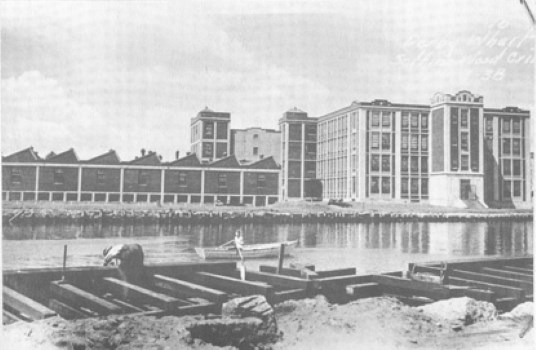Part of a series of articles titled Salem's Polish Community.
Previous: Chopin Choir
Article

NPS Photo
Salem's "golden age" of maritime trade was over by the 1830s, and like many New England towns and cities, it turned to manufacturing in the later part of the nineteenth century. By the time Poles began arriving in numbers in the city, it was the site of large and small factories, many of them producing leather goods and textiles.
The Derby Street neighborhood was home to many of these factories, including numerous small leather companies and also the city's largest mill: the "Pequot Mill" (named for the brand of sheeting it was known for producing) of the Naumkeag Steam Cotton Company. The original mill burned down during the 1914 Salem Fire; however, it was quickly rebuilt and modernized, and continued to operate until the early 1950s.
Many of the immigrant and later Poles found work in these industries. Factory work tended to be gendered: men were more likely to work in leather and women in textiles. Poles were known for their strong work ethic and also for their willingness to stand up to employers for their rights. In 1933, workers at the Pequot Mill went strike in defiance of their own union, largely over questions of seniority in hiring. This issue particularly affected married women, like Mary Nowak, who lost their seniority when they took time off to have children. Most of these women were Polish and French Canadian; the strikers' meetings were conducted in English, French, and Polish, and there was considerable ethnic solidarity despite the opposition of city officials, the local newspaper, and other powerful voices in the community.
After several weeks, the strikers' demands were met, but it was a somewhat hollow victory, as manufacturing in New England was already in deep decline and Salem's waterfront area was once again losing its economic vitality. The establishment of Salem Maritime National Historic Site in 1938 was part of an effort to revive the neighborhood by preserving some of its most significant historic buildings and structures, like the Custom House and Derby Wharf. For Poles, though, the creation of the park also entailed some loss, as a number of homes and businesses were demolished to make room for the new national park.
The changes signaled by the decline in industry and the reframing of Salem's waterfront as a historic area were part of a shift experienced in many Polish and other ethnic communities in the middle decades of the twentieth century. With changes in work and housing patterns, the tight-knit web of clubs, stores, restaurants, and bars began to break up, and Derby Street's character as Salem's "Polish Main Street" began to change.
Part of a series of articles titled Salem's Polish Community.
Previous: Chopin Choir
Last updated: August 24, 2021